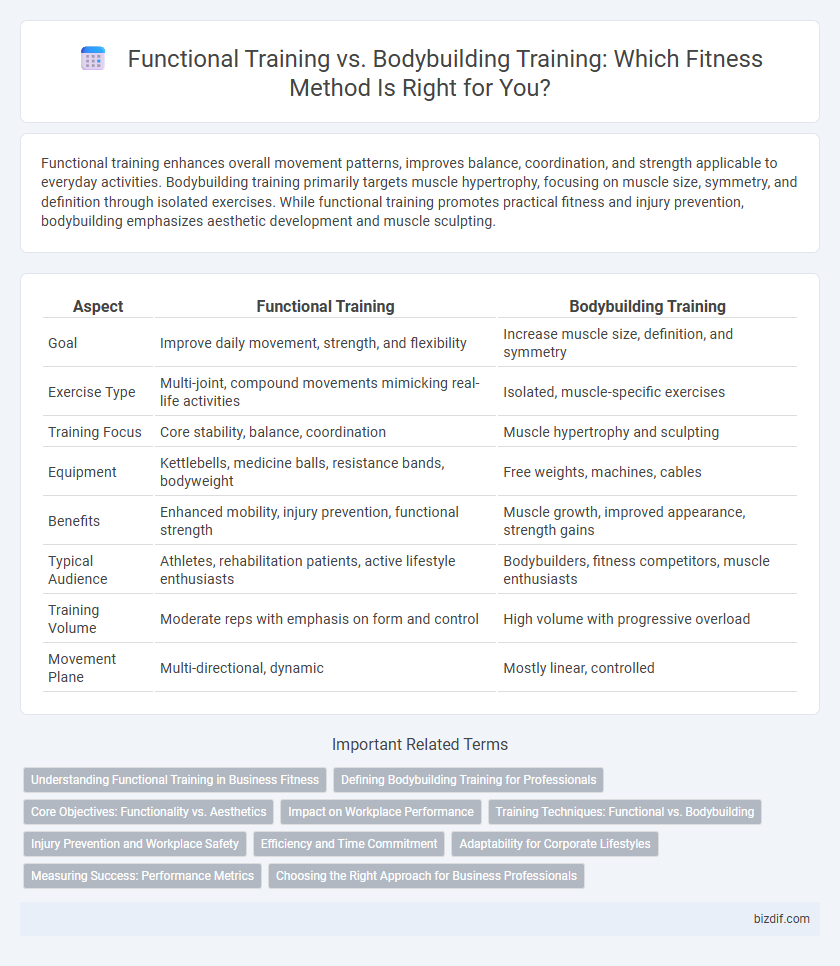Functional training enhances overall movement patterns, improves balance, coordination, and strength applicable to everyday activities. Bodybuilding training primarily targets muscle hypertrophy, focusing on muscle size, symmetry, and definition through isolated exercises. While functional training promotes practical fitness and injury prevention, bodybuilding emphasizes aesthetic development and muscle sculpting.
Table of Comparison
| Aspect | Functional Training | Bodybuilding Training |
|---|---|---|
| Goal | Improve daily movement, strength, and flexibility | Increase muscle size, definition, and symmetry |
| Exercise Type | Multi-joint, compound movements mimicking real-life activities | Isolated, muscle-specific exercises |
| Training Focus | Core stability, balance, coordination | Muscle hypertrophy and sculpting |
| Equipment | Kettlebells, medicine balls, resistance bands, bodyweight | Free weights, machines, cables |
| Benefits | Enhanced mobility, injury prevention, functional strength | Muscle growth, improved appearance, strength gains |
| Typical Audience | Athletes, rehabilitation patients, active lifestyle enthusiasts | Bodybuilders, fitness competitors, muscle enthusiasts |
| Training Volume | Moderate reps with emphasis on form and control | High volume with progressive overload |
| Movement Plane | Multi-directional, dynamic | Mostly linear, controlled |
Understanding Functional Training in Business Fitness
Functional training emphasizes movements that mimic real-life activities to improve overall strength, balance, and flexibility, making it highly effective for enhancing workplace performance and reducing injury risk. Unlike bodybuilding training, which isolates muscle groups for aesthetic development, functional training integrates multiple muscle groups to optimize practical, everyday physical tasks. Businesses adopting functional training programs see increased employee productivity, better posture, and decreased absenteeism due to improved physical health.
Defining Bodybuilding Training for Professionals
Bodybuilding training for professionals centers on hypertrophy through targeted resistance exercises designed to maximize muscle size and symmetry. It involves structured routines emphasizing progressive overload, isolation movements, and precise nutrition to optimize muscle recovery and growth. This specialized training prioritizes muscle definition and aesthetics over functional movement patterns.
Core Objectives: Functionality vs. Aesthetics
Functional training emphasizes improving everyday movement patterns, balance, and overall mobility to enhance physical performance and reduce injury risk. Bodybuilding training prioritizes muscle hypertrophy and symmetry to achieve an aesthetically pleasing physique by targeting specific muscle groups with isolation exercises. Core objectives in functional training revolve around practical strength and adaptability, while bodybuilding focuses on muscle size and definition.
Impact on Workplace Performance
Functional training enhances workplace performance by improving overall mobility, balance, and core strength, which reduces injury risk and increases efficiency in daily tasks. Bodybuilding training primarily builds muscle hypertrophy and strength, potentially boosting physical power but with less emphasis on practical movement patterns relevant to typical job functions. Employees engaging in functional training often experience better posture and endurance, leading to increased productivity and decreased absenteeism.
Training Techniques: Functional vs. Bodybuilding
Functional training emphasizes multi-joint, compound movements that mimic real-life activities to improve overall strength, coordination, and mobility. Bodybuilding training prioritizes isolated muscle exercises, targeting specific muscle groups to maximize hypertrophy and muscle definition. Functional training typically uses dynamic, full-body movements with equipment like kettlebells and resistance bands, while bodybuilding relies heavily on machines and free weights for focused muscle stimulation.
Injury Prevention and Workplace Safety
Functional training enhances injury prevention by mimicking real-life movements that improve joint stability, balance, and core strength, which are critical for workplace safety. Bodybuilding training primarily targets muscle hypertrophy and symmetry, which may not directly translate to functional strength or reduce injury risk during daily work tasks. Integrating functional training into fitness programs promotes safer work environments by preparing muscles and joints for unpredictable motions encountered on the job.
Efficiency and Time Commitment
Functional training enhances overall movement efficiency by targeting multiple muscle groups simultaneously, making workouts practical for daily activities and reducing time spent exercising. Bodybuilding training emphasizes muscle isolation and hypertrophy, often requiring longer sessions and frequent gym visits to achieve desired muscle size and definition. For those prioritizing time commitment, functional training offers a more efficient approach by combining strength, flexibility, and endurance in shorter, impactful workouts.
Adaptability for Corporate Lifestyles
Functional training enhances adaptability for corporate lifestyles by targeting practical movements that improve posture, reduce injury risk, and boost overall energy levels during sedentary work hours. Bodybuilding training primarily focuses on muscle hypertrophy and aesthetic goals, which may offer less direct benefit for daily functional tasks or prolonged sitting. Integrating functional exercises supports dynamic movement patterns essential for maintaining productivity and health in office environments.
Measuring Success: Performance Metrics
Functional training measures success through improvements in real-life movements, such as enhanced agility, balance, and strength in daily activities. Bodybuilding training evaluates progress primarily by muscle hypertrophy, symmetry, and overall physique aesthetics using metrics like muscle circumference and body fat percentage. Performance metrics in functional training emphasize practical strength and flexibility, while bodybuilding focuses on muscle definition and size.
Choosing the Right Approach for Business Professionals
Functional training enhances daily movement efficiency, improves core stability, and reduces injury risk, making it ideal for busy business professionals seeking practical fitness benefits. Bodybuilding training focuses on muscle hypertrophy and aesthetic development but requires more time commitment and recovery, which may be challenging with demanding work schedules. Selecting functional training supports productivity and energy levels, aligning better with the lifestyle constraints of corporate environments.
Functional Training vs Bodybuilding Training Infographic

 bizdif.com
bizdif.com